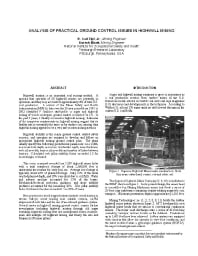Mining Publication: Analysis of Practical Ground Control Issues in Highwall Mining
Original creation date: August 2004
Authors: RK Zipf, SK Bhatt
NIOSHTIC2 Number: 20025346
In: Peng SS, Mark C, Finfinger GL, Tadolini SC, Heasley KA, Khair AW, eds. Proceedings of the 23rd International Conference on Ground Control in Mining. Morgantown, WV, August 3-5, 2004: West Virginia University, 2004; :210-219
Highwall mining is an important coal mining method. More than 60 highwall miners are presently in operation, and they may account for about 4% of total U.S. coal production. A review of accident data for 1983-2002 from the Mine Safety and Health Administration identified nine fatalities attributable to auger and highwall mining, of which inadequate ground control accounted for one-third. In the past 5 years, one fatality occurred in highwall mining. Estimates of the manpower requirements in highwall mining suggest that its fatality rate is essentially the same as for surface coal mining; thus, highwall mining seems to be a very safe modern mining method. Highwall stability is the major ground control-related safety concern, and operators are required to develop and follow an appropriate highwall mining ground control plan. The plans usually specify the following geotechnical parameters: hole width, maximum hole depth, maximum overburden depth, seam thickness, web pillar width, barrier pillar width, and number of holes between barriers. The calculated web pillar stability factor exceeded 1.3 for most designs evaluated. This study examined records from 5,289 highwall miner holes with a total completed footage of about 2.56 million ft to understand the reasons for early pullout. Average lost footage is typically about 20% of planned footage. Only 35% of the holes reached planned depth, and 20% were short due to rock falls. Water and adverse geology accounted for 15% of the losses. Mechanical/electrical problems, guidance, and slope stability problems accounted for the remaining 30%. The web pillar stability factor for these holes also exceeded 1.3 in 95% of cases. Trapped highwall miners present a safety hazard to workers during their recovery. Best practices to avoid trapped highwall miners include: avoid mining in stream valleys, avoid mining near outside corners, carefully align each hole, and use an onboard guidance system. Several issues in highwall mining ground control require further investigation, including highwall mining through old auger workings, highwall mining near old underground mines, multiple-seam and multiple-lift highwall mining, and the size and frequency of barrier pillars.

NIOSHTIC2 Number: 20025346
In: Peng SS, Mark C, Finfinger GL, Tadolini SC, Heasley KA, Khair AW, eds. Proceedings of the 23rd International Conference on Ground Control in Mining. Morgantown, WV, August 3-5, 2004: West Virginia University, 2004; :210-219
- Analysis of Safety Aspects and Mining Practices for Effective Ground Control in Surface Mining
- ARMPS-HWM - Analysis of Retreat Mining Pillar Stability - Highwall Mining - 1.3.02
- Practical Risk Assessment Guidelines for Identifying, Assessing, and Mitigating Stored Energy Hazards in Underground Coal Mines During and After a Mine Emergency
- Preventing Equipment Related Injuries in Underground U.S. Coal Mines
- Slope Stability
- SPONCOM - A Computer Program for the Prediction of the Spontaneous Combustion Potential of an Underground Coal Mine
- SponCom - Spontaneous Combustion Assessment Software - 2.0
- Technology News 462 - Ground Penetrating Radar for Highwall Guidance
- Technology News 516 - ARMPS-HWM: New Software for Sizing Pillars for Highwall Mining
- Technology News 545 - NIOSH Updates Spontaneous Combustion Assessment Software
- Using Fault-Tree Analysis To Focus Mine Safety Research